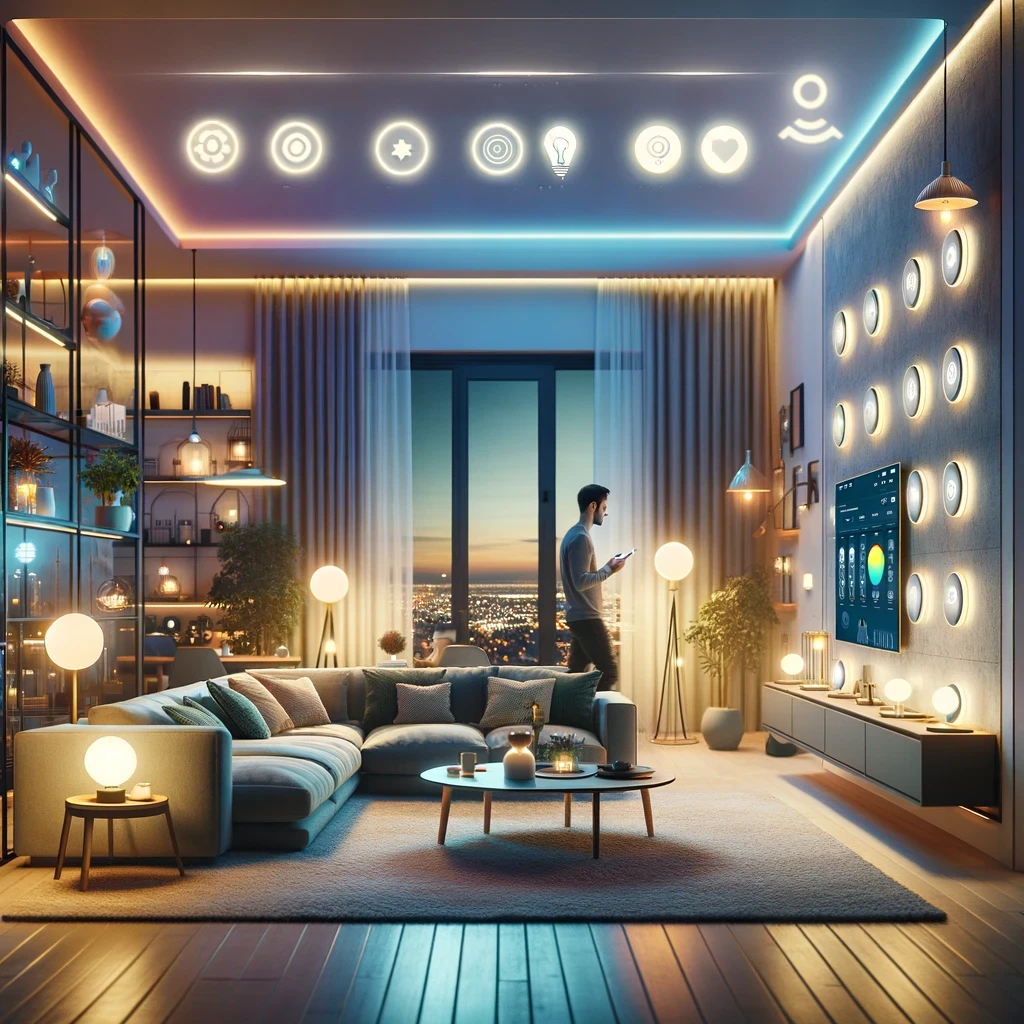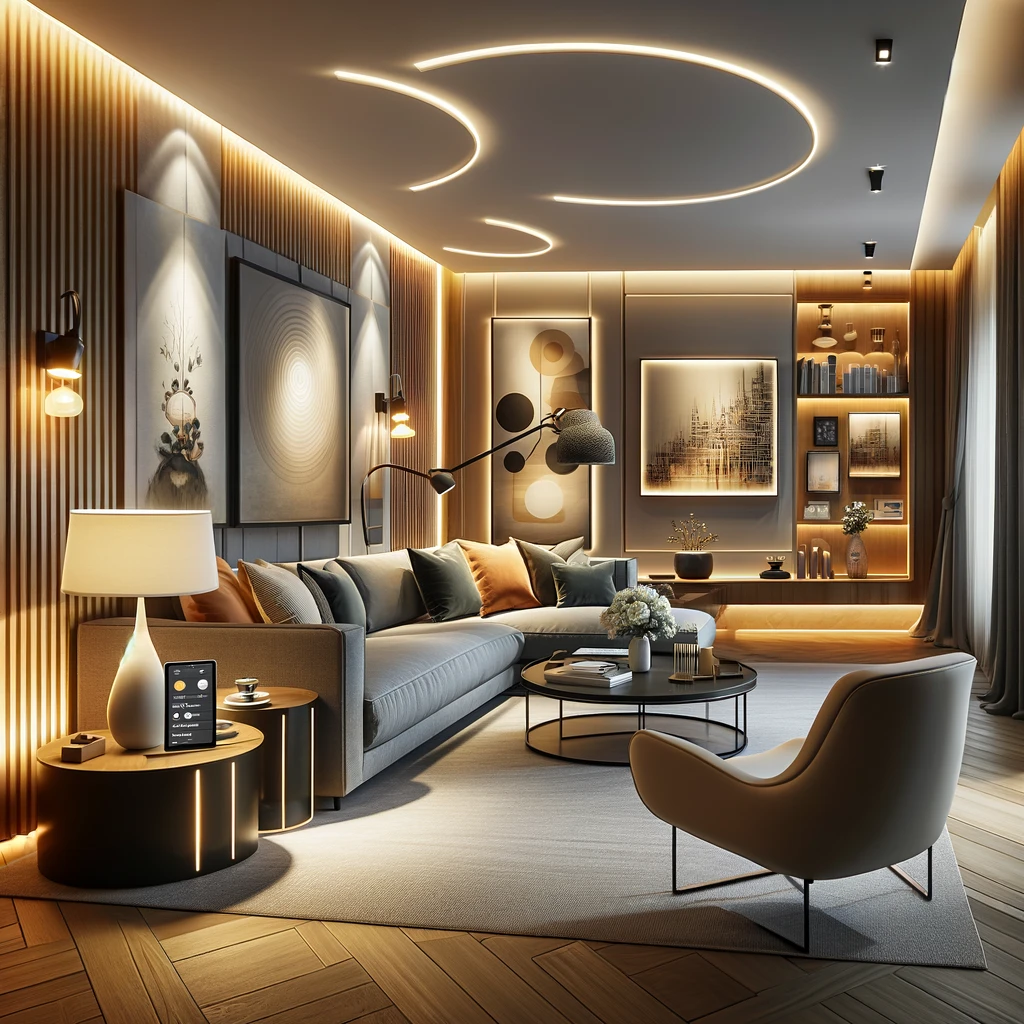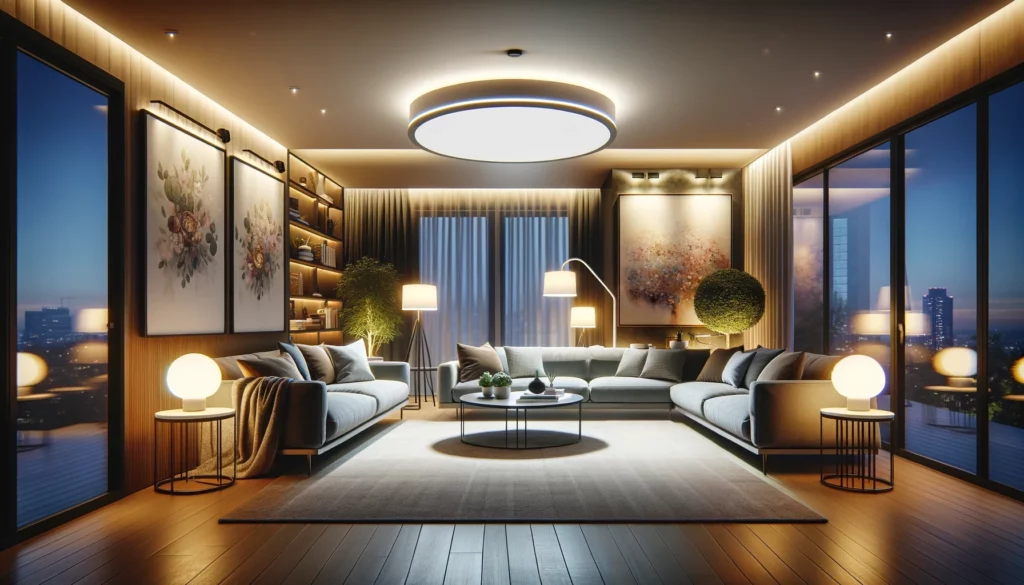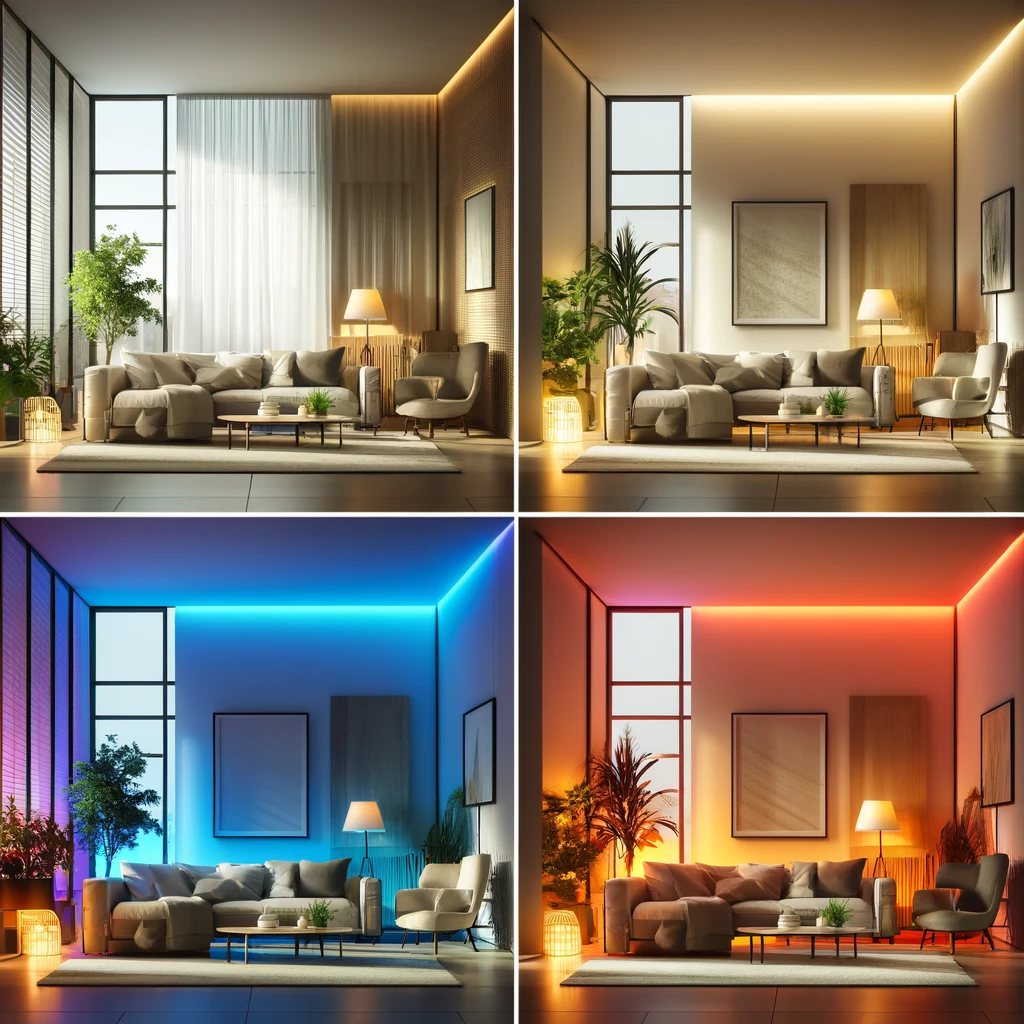Smart Home Lighting Tips: What is Smart Home Lighting?
Picture a world where your lights change at your every whim, coming on just when you enter a room, dimming to enjoy movie night and even going from bright white light in the morning to warm yellow hues to ease you awake. This is the wonder of smart home lighting, a technology that’s changing the way we live in our houses.
Smart Home Lighting is a group of connected lighting devices to enable you control them from your smartphone app, by voice or scheduled automatically. Smart Lighting: Light Switches Traditional vs. Smart lighting provides complete light control in your home, making managing the lights more convenient and energy-saving for first-time homeowners like you!
Instead of manually flicking switches or searching for light switches, you can adjust the mood in your home with a swipe on your phone. You are able to do this, in a way for example on the lights to start automatically with sunset or turn down your lights slowly as you get ready sleep so you can have a good atmosphere for relaxation.
Top Reasons to Opt for Smart Home Lighting
Of course, a smart lighting system offers more than just the luxury of managing your lights from anywhere — that convenience is only the beginning. Smart home lighting system: So why should you even bother to install smart lighting in your home?
Comfort: Goodbye to stumbling feat when you get up in the night. Believe it or not, but with smart lighting you can control your lights anywhere in your house — even from the other side of the world. Light turns on the porch light as you pull into your driveway, sets a romantic atmosphere for a dinner party with friends and more straight from your displayers device
Energy Efficiency: You can now save on power and energy too. The lights can even dim or turn off when a room is unoccupied, saving unnecessary energy. Smart lighting systems also frequently come with scheduling options, where you can set your lights to automatically switch off in the night or when you leave the house.
One of the biggest benefits in favor of using smart bulbs or fixtures within, is to add an extra layer of security to your abode. If it senses motion, so you can prevent them with their oncoming lights directed toward possible access points. Smart lighting can even help give the impression that someone is at home when you are not.
Flexible Mood Control: With Smart lighting, you can set alternate atmospheres according to the mood. Color-changing bulbs can create different vibes for a chill evening, exciting party, and productive work session. It will also enable you to sync your smart lights with your favorite music or TV for a mesmerizing experience.
Flexibility: One of the most interesting things about smart home lighting would undoubtedly be its customization. There are lots of different bulbs, fixtures and automation options available, to customize the lighting you set up to how you want it. From simple upgrades to complete home automation systems, smart lighting can be tailored to suit virtually any need.
Different Types of Smart Lighting Devices
With that context established, let’s get into the different bits and pieces that make up a smart home lighting system. Since each device has a different purpose, you can create your beautiful lighting setup completely according to your needs and preferences.
Smart Bulbs: The smart bulb is the most basic form of smart light and it is simple to understand as they are like normal LED bulbs but connected. They then connect to your Wi-Fi network and can be controlled from an app or with your voice. This includes dimming, color-changing and the ability to set schedules for many smart bulbs.
Smart Switches: Get the best local offer – Check PricesThese replace your current light switches and leave them with full basic switch characteristics along with smart home capabilities. They can be remotely-controlled and frequently connect to smart home hubs for increased automation.
Smart Plugs: Your lamps and devices become smart with the help of smart plugs. Plug your device into the smart plug, and let you control it through an app or voice.
Light Strips are flexible LED strips that will bring ambient light to any room. Available in different colors and lengths, a lot of today’s models also are wireless and can be linked to networked home automation systems.
Smart dimmers: A smart dimmer enables you to set the lights at just the right brightness level for any situation. These often work with other smart lightbulbs for unified control.
Sensors: Sensors of different types such as motion sensors, light sensors can be combined with the fitting to perform some actions automatically. Using light sensors to make your connected lights brighter or dimmer depending on the amount of natural lighting in a room, for example!
Remotes & Wall Controllers: Remotes and wall controllers give old fashion feel in controlling smart lighting. These allow you to control someone channels of LEDs individually manually or trigger programmed scenes without needing your phone.
Smart Hub / Assistant compatibility
Many smart lighting devices can talk directly to your Wi-Fi network, but some require a central hub for smarts and connectivity. These hubs work as a one-stop-shop for all your smart home devices enabling them to talk amongst themselves — and through a smartphone, or better said, voice assistant.
Smart Hubs: Common smart hubs include Philips Hue, Samsung SmartThings and Amazon Echo. These hubs usually work with a certain wireless protocol such as Zigbee or Z-Wave and can therefore be used to control multiple brands of smart light devices.
Voice Assistants: Voice assistants such as Alexa, Google Assistant and Siri can easily be connected to smart lighting. Just connect your smart lights to a voice assistant and control the lighting by accessing specific spoken commands. It is the ultimate in no muss, no fuss!
If you’re planning to use smart lights in conjunction with the rest of a smart home, it’s important that these different devices and systems work well together. They offer functionality that if compatible is designed to work straight away with your smart hub and voice assistant.
Balancing Needs: Specifications vs Budget
Smart home lighting can be confusing to navigate, and there’s a lot of decisions to make when it comes time to buy a system for your home that won’t cost you an arm and leg but still has all the features you want. Smart Lighting: Smart bulbs can be as simple and inexpensive as a Phillips HUE bulb, or they can be part of complete systems that have full automation capabilities.
This is where knowing what you want to trade-off for its corresponding price point will be extremely useful, as it allows for the optimal budgeting of your establishment.
Determining Your Budget:
The first thing to do is start small: If you are just dipping your toes into smart home technology, try starting with more minor implementations. For example, start out with replacing a handful of light bulbs in important rooms like your living room or bedroom with smart bulbs. That’s enough to get you into smart lighting territory without completely breaking the bank.
Check Out Bundles: Certain manufacturers sell their smart lighting solutions in bundles that often include a hub and a set of smart bulbs. In many cases, this bundles combine is the best way to start if you enter with a home lighting system.
Always Buy on Sales and Discounts: Be sure to check for sales/discounts from time to time in case they pop up on smart lighting devices. They frequently make excellent deals available both on the internet for direct selling and also via leading stores
Prioritizing Features:
If you just want the most basic form of control — to turn lights on or off remotely, or set up a schedule for them — then smart bulbs and smart plugs make a whole lot more sense.
Color Changing / Dimming Attractive features to look for in smart bulbs Color-changing or dimmable.
Automation & integration: If you are after an automated system which integrates with other smart home devices, then look at the smart hubs and systems that provide a wider range of automation options.
Energy Efficiency: Replace traditional incandescent bulbs with energy-efficient LED bulb which consumes less power.
Easy DIY or Professional Installation?
After you’ve chosen your devices, the next decision is whether you will self-install them or use a pro. The choice is yours, and it ultimately comes down to how comfortable you feel with running electrical, how automated you want everything, and your budget.
The plug and play set up: Retrofit Devices such as smart bulbs, smart plugs and some light strips do not require altering any electrical cabling so it is an easy do-it-yourself job.
Old-school Wiring: Anyone who has elbowed their way into the electrical box can pull apart two wires and twist on some caps.
DIY vs Hiring a Professional Cost Savings: Installing on your own will save you a lot of money compared to hiring someone.
Safety: Depending on the task that needs to be done, working with electricity can be dangerous and usually best suited for the pros when handling any complex wiring work.
A well-informed decision on which way to go between DIY and hiring professionals will be made clear by weighing these pros and cons that provide you with a safe implementation of your smart home lighting system.

Convenience through Lighting: Smart Light Control
Much of the appeal to make way for smart home lighting, is the convenience it provides that cannot be matched. No matter where you are in your house, or even if you’re miles away, the possibility of your lights being controlled with a simple voice command or tap on your phone is truly something straight out of science fiction.
Remote Control:
Smartphone Apps: Most smart lighting systems even come with their own smartphone apps that allow you to control them remotely. Change the lights, turn them on or off, adjust brightness levels and colors, and even set a schedule (you can customize it from your smart phone)!
Hands-Free: Voice Commands will change the game. Just connect your smart lights with a voice assistant such as Alexa, Google Assistant or Siri and you could control the light using voice commands. The next time you tell lights in the living room to “Turn on,” or request they be dimmed down in the bedroom, your smart lights will respond with zero latency.
Remote Control: Even if you are not at home, smart lighting creates the ability to turn your lights on or off turning it off from anywhere in the world. Need the lights on when you get home, there is a smartphone app or web interface for that, want to appear at home as a deterrent In-steer through firmware corrections letting some can control (power plug et al.) do its job and more
Scheduling:
Another very practical application for these smart lighting system is the ability to create automated routines for your lights! Or having your lights turn on as the sun is setting to create a warm, inviting feeling when you arrive back home. It also allows you to switch your lights back off at bedtime, so they do not run all night while you sleep.
Smart Lighting System Schedules Customizable HinThe Smart lighting systems provide users with various scheduling options. For weekdays, weekends and holidays with various schedule. It can even simulate a sunrise by slowly turning on the lights in the morning and waking you up.
Automations:
To make things even easier, add some motion sensors in your living room and connect them to smart lights — they light up as soon as a movement is detected. Great for hallways, stairwells and outdoor pathways the light will only turn on when you need it but otherwise conserve energy.
Geofencing: Support full automation by going geofencing. Through your smartphone, you can program the lights to turn on as you pull up to your house — providing light from your vehicle’s arrival and making it so much easier for those late nights in.
Sunrise/Sunset Routines: Sunrise/sunset routines are like nature-based cheat codes. If you want your lights to slowly get brighter in the morning like a sunrise, and fade out as the sun lowers itself at night creating that relaxed atmosphere of tranquility.
The concept of smart lighting is to provide more comfort and savings in your daily life. Similarly, with the help of remote control, scheduling and automation features available in smart homes you can turn your home into this wonderful space that is going to respond just as what you exactly need at the right time.
Using Smart Lighting around the House To Save Energy and Money
In addition to this, smart home lighting is a very powerful tool to help reduce energy consumption and lower your utility bills! By using automation and aware control, you can get the most out of usage with a reduced energy loss thereby leading to a more sustainable approach.
Dimming:
Adjust Brightness: Smart dimmers keep you from using more light than what is necessary, letting you finely tune the brightness of your lights. Low light levels establish a more comfortable and relaxed environment while they power uses a significant amount of energy.
Energy Savings: A small dimming can make a big difference in energy savings. Just dimming your lights by 10% save you up to 10% on your power bill.
Auto-off Features:
This could include things like occupancy detection, as many smart lights and hubs do today to turn the lights off when no one is in a room. This will keep you from leaving your lights on all day and night unaware that any of the lights are still running, using unnecessary energy and only adding on to your utility bill.
Timer: Set the lights to automatically turn off after a time. For example, if you’re prone to forgetting your lights on after you leave the bathroom.time them to turn off 10 minutes (or whatever duration requires) once they sense no motion in the room.
Energy-efficient LED Bulbs:
Less Energy Usage: LED bulbs consume a fraction of the energy required for traditional incandescent lighting. This results in power efficiency, using up to 80% less energy so you will see real savings on your energy bill.
Leading LED bulbs are several tens of times more durable than regular incandescent yuntami, so they do not need to be replaced as often.
Smart Lighting for Security:
Motion-activated Outdoor Lights — Motion activated outdoor lights that only come on when motion is detected, and discourage intruders by lighting area of potential entry. The lights are activated only when necessary, to save electricity, and function as an important safety feature.
Faux Occupancy: Create a schedule for your lights to come on and go off at odd intervals, simulating an occupied space even when you’re out. This gives the appearance that there is someone actually home to deter would-be burglars.
These energy-saving tips not only help you shrink your carbon footprint, but also save your hard earned-wages on utility bills. Smart lighting provides you with the controls to save energy and create an environment-friendly home.
Beyond Brightness: The New Age of Smart Lighting
Smart lighting is already changing the game when it comes to helping homeowners control light use and save energy, but with advances in technology, smart lighting has nowhere to go but up. The future of smart home lighting
Improved Automation: There will be more evolved automation features on display. Systems like these would learn your preferences/routines and adjust light levels, colors, etc based on need/habit (automated smart lighting)
Interconnectivity with other smart home devices: Smart lighting will also be more interconnected with your other… smarter home devices, allowing it to act as a single conscious network in an intelligent environment of some sort. When contemplating about temporal and humidity or even sound levels in your house, consider how your lighting automatically adjusts.
Customized Lighting: Custom lighting will become Design 101. In future, smart lighting systems will cater to your specific preferences and adjust light levels, colors and even brightness according to the need such as for someone with visual impairment.
Energy Efficiency Enhancements: Smart lighting will only get more energy-efficient. But we can expect to see bulbs that are heftier, brighter LEDs and smarter control systems that further dial in energy consumption from week-to-week.
The future for smart home lighting is as bright as ever with exciting new features, further automation and more personalisation opportunities. Smart lighting will be the evolved heart of an authentic intelligent and responsive home where we can live a life with comfort, save energy and enjoy every bit they living style by adding values to our modern daily lives.
For detailed information about lighting, don’t miss our The Transformative Tips for Effective Home Lighting 2024: Transform Your Space with Light
Smart Home Lighting: Frequently Asked Questions
Types of smart lighting devices
There are different types of devices that serve multiple functions in a smart home lighting system. These include:
- Smart bulbs: Traditional light bulbs with added smarts, controlled remotely.
- Smart switches: Replace any of the dumb ones you have in your home right now and allow for remote control as well as automation.
- Smart plugs: Turn any lamp or standard device into a smart device.
- Light strips: With various color options and a remote control for it, so you can leave different colors on.
- Dimmers: Control how very bright your spaces are, depending on the mood!
- Sensors: These detect motion, light or any other condition and will then respond with an action.
- Remote controls and wall controllers: Provide options for manual operation
How do smart lights help us save energy?
The primary reasons lights are smart is they use less energy:
- Dimming: Increase or decrease the brightness, light only when needed.
- Auto-off features: Lights switch themselves off when no one is in a room or after a certain time interval.
- Energy-efficient LED bulbs: Significantly low-power consuming than Old bulbs
Do I need a smart hub for smart lighting?
Some smart lights talk directly to your Wi-Fi, others require a central hub for communication and control. Philips Hue, Samsung SmartThings, and Amazon Echo supports specific protocol such as Zigbee or Z-Wave; these are examples of smart hubs. That serves as a hub for all of your connected devices, allowing them to talk to each other and respond to commands from your phone or voice assistant.






